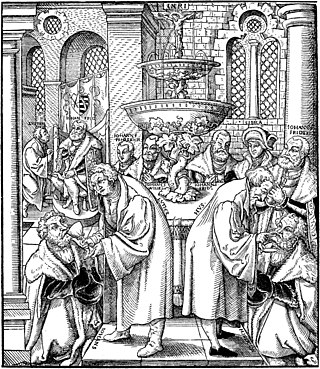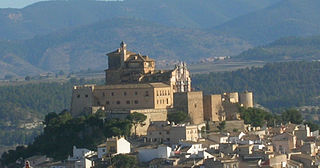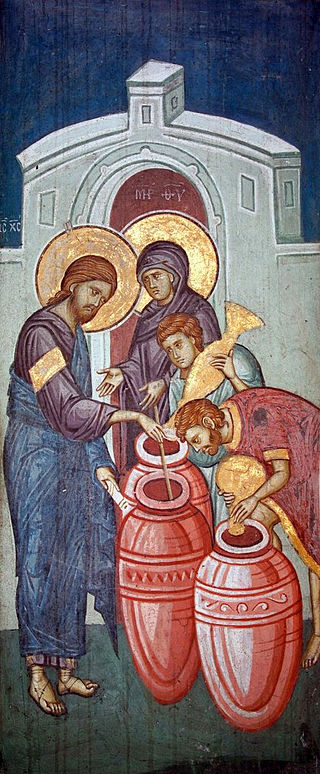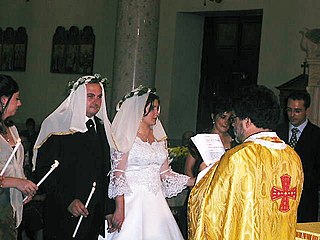Related Research Articles

Baptism is a Christian sacrament of initiation almost invariably with the use of water. It may be performed by sprinkling or pouring water on the head, or by immersing in water either partially or completely, traditionally three times, once for each person of the Trinity. The synoptic gospels recount that John the Baptist baptised Jesus. Baptism is considered a sacrament in most churches, and as an ordinance in others. Baptism according to the Trinitarian formula, which is done in most mainstream Christian denominations, is seen as being a basis for Christian ecumenism, the concept of unity amongst Christians. Baptism is also called christening, although some reserve the word "christening" for the baptism of infants. In certain Christian denominations, such as the Catholic Churches, Eastern Orthodox Churches, Oriental Orthodox Churches, Assyrian Church of the East, and Lutheran Churches, baptism is the door to church membership, with candidates taking baptismal vows. It has also given its name to the Baptist churches and denominations.

The Eucharist, also known as Holy Communion, Blessed Sacrament and the Lord's Supper, is a Christian rite that is considered a sacrament in most churches, and as an ordinance in others. Christians believe that the rite was instituted by Jesus at the Last Supper, the night before his crucifixion, giving his disciples bread and wine. Passages in the New Testament state that he commanded them to "do this in memory of me" while referring to the bread as "my body" and the cup of wine as "the blood of my covenant, which is poured out for many". According to the Synoptic Gospels this was at a Passover meal.

Transubstantiation is, according to the teaching of the Catholic Church, "the change of the whole substance of bread into the substance of the Body of Christ and of the whole substance of wine into the substance of the Blood of Christ". This change is brought about in the eucharistic prayer through the efficacy of the word of Christ and by the action of the Holy Spirit. However, "the outward characteristics of bread and wine, that is the 'eucharistic species', remain unaltered". In this teaching, the notions of "substance" and "transubstantiation" are not linked with any particular theory of metaphysics.

Mission Basilica San Diego de Alcalá was the second Franciscan founded mission in The Californias, a province of New Spain. Located in present-day San Diego, California, it was founded on July 16, 1769, by Spanish friar Junípero Serra, in an area long inhabited by the Kumeyaay people. The mission and the surrounding area were named for the Catholic saint Didacus of Alcalá, a Spaniard more commonly known as San Diego. The mission was the site of the first Christian burial in Alta California. The original mission burned in 1775 during an uprising by local natives. San Diego is also generally regarded as the site of the region's first public execution, in 1778. Father Luis Jayme, California's first Christian martyr who was among those killed during the 1775 uprising against the mission, lies entombed beneath the chancel floor. The current church, built in the early 19th century, is the fifth to stand on this location. The mission site is a National Historic Landmark.

In Christianity, ablution is a prescribed washing of part or all of the body or possessions, such as clothing or ceremonial objects, with the intent of purification or dedication. In Christianity, both baptism and footwashing are forms of ablution. Prior to praying the canonical hours at seven fixed prayer times, Oriental Orthodox Christians wash their hands and face. In liturgical churches, ablution can refer to purifying fingers or vessels related to the Eucharist. In the New Testament, washing also occurs in reference to rites of Judaism part of the action of a healing by Jesus, the preparation of a body for burial, the washing of nets by fishermen, a person's personal washing of the face to appear in public, the cleansing of an injured person's wounds, Pontius Pilate's washing of his hands as a symbolic claim of innocence and foot washing, which is a rite within the Christian Churches. According to the Gospel of Matthew, Pontius Pilate declared himself innocent of the blood of Jesus by washing his hands. This act of Pilate may not, however, have been borrowed from the custom of the Jews. The same practice was common among the Greeks and Romans.

The wedding at Cana is the name of the story in the Gospel of John at which the first miracle attributed to Jesus takes place.

Sacramental bread, also called Communion bread, Communion wafer, Sacred host, Eucharistic bread, the Lamb or simply the host, is the bread used in the Christian ritual of the Eucharist. Along with sacramental wine, it is one of two elements of the Eucharist. The bread may be either leavened or unleavened, depending on tradition.
An abstemius is one who cannot take wine without risk of vomiting. Since in Catholic practice the consecration at Mass must be effected in both species, of bread and wine, an abstemius is consequently irregular.

Utraquism or Calixtinism was a belief amongst Hussites, a reformist Christian movement, that communion under both kinds should be administered to the laity during the celebration of the Eucharist. It was a principal dogma of the Hussites and one of the Four Articles of Prague.

Teano is a town and comune in the province of Caserta, Campania, southern Italy, 30 kilometres (19 mi) northwest of Caserta on the main line to Rome from Naples. It stands at the southeast foot of an extinct volcano, Rocca Monfina. Its St. Clement's cathedral is the see of the Roman Catholic Diocese of Teano-Calvi, which started as the Diocese of Teano circa AD 300.

Caravaca de la Cruz, often shortened to Caravaca, is a town and municipality of southeastern Spain in the region of Murcia, near the left bank of the River Argos, a tributary of the Segura. It is the capital of the northwest Region of Murcia. It has a population of 26,449 as of 2010. In 1900, it had 15,846 inhabitants.

The antidoron is ordinary leavened bread which is blessed but not consecrated and distributed in certain Eastern Orthodox Churches and certain Eastern Catholic Churches that use the Byzantine Rite. It comes from the remains of the loaves of bread (prosphora) from which portions are cut for consecration as the Eucharist during the Divine Liturgy. The word Ἀντίδωρον means "instead of gifts", i.e., "instead of the Eucharistic gifts". A blessed bread akin to antidoron, pain bénit, is used in some French and Canadian Latin Catholic churches as a substitute for those unable to receive the Eucharist.
The Encratites ("self-controlled") were an ascetic 2nd-century sect of Christians who forbade marriage and counselled abstinence from meat. Eusebius says that Tatian was the author of this heresy. It has been supposed that it was these Gnostic Encratites who were chastised in the epistle of 1 Timothy (4:1-4).

Blood of Christ, also known as the Most Precious Blood, in Christian theology refers to the physical blood actually shed by Jesus Christ primarily on the Cross, and the salvation which Christianity teaches was accomplished thereby, or the sacramental blood (wine) present in the Eucharist or Lord's Supper, which some Christian denominations believe to be the same blood of Christ shed on the Cross.

Eucharist is the name that Catholics give to the sacrament by which, according to their belief, the body and blood of Christ are present in the bread and wine that are consecrated during the Catholic eucharistic liturgy, generally known as the Mass. The definition of the Eucharist in the 1983 Code of Canon Law as the sacrament where Christ himself "is contained, offered, and received" points to the three aspects of the Eucharist according to Catholic theology: the real presence of Christ in the Eucharist, Holy Communion, and the holy sacrifice of the Mass.

Christian views on alcohol are varied. Throughout the first 1,800 years of Church history, Christians generally consumed alcoholic beverages as a common part of everyday life and used "the fruit of the vine" in their central rite—the Eucharist or Lord's Supper. They held that both the Bible and Christian tradition taught that alcohol is a gift from God that makes life more joyous, but that over-indulgence leading to drunkenness is sinful. However, the alcoholic content of ancient alcoholic beverages was significantly lower than that of modern alcoholic beverages. The low alcoholic content was due to the limitations of fermentation and the nonexistence of distillation methods in the ancient world. Rabbinic teachers wrote acceptance criteria on consumability of ancient alcoholic beverages after significant dilution with water, and prohibited undiluted wine.
Confessor of the Faith is a title given by some Christian denominations. In Catholicism and Eastern Orthodoxy, Christians who professed their faith in times of Christian persecution and therefore had to suffer persecution, expulsion, torture, mutilation and imprisonment, but not directly undergo martyrdom, are called confessors. Later, popes, bishops, abbots, kings and hermits were also counted among the confessors.

The Daniel Fast, in Christianity, is a partial fast, in which meat, dairy, alcohol, and other rich foods are avoided in favor of vegetables and water in order to be more sensitive to God. The fast is based on the lifelong kosher diet of the Jewish prophet Daniel in the biblical Book of Daniel and the three-week mourning fast in which Daniel abstained from all meat and wine. Among Catholic and Mainline Protestant Christians, the Daniel Fast has been practiced by some during the 40-day season of Lent, though the Daniel Fast can variously be set at three weeks, or even ten days. As such, evangelical Christian churches such as those of the Baptist tradition, have partaken in the fast at various times of the year. The passage in Chapter 1 refers to a 10-day test wherein Daniel and others with him were permitted to eat vegetables and water to avoid the Babylonian king's food and wine. After remaining healthy at the end of the 10-day period, they continued the vegetable diet for the three years of their education. The passage in Chapter 10 refers to a three-week fast of no meat, wine, or rich food. In addition to the practices of fasting and abstinence undertaken during the Daniel Fast, Christians may also add spiritual disciplines such as daily church attendance, increased prayer, as well as the reading of Sacred Scripture and a daily devotional.
Stercoranism is a supposed belief or doctrine attributed reciprocally to the other side by those who in the eleventh century upheld and those who denied the Christian doctrine of transubstantiation, that the bread and wine offered in the Eucharist become in substance, but not in form, the body and blood of Jesus Christ.

The Mystery of Crowning is a ritual component of the sacrament of marriage in Eastern Christianity. Variations of the crowning ceremony exist in multiple liturgical rites, including the Byzantine, Coptic, West Syriac, and East Syriac Rites of the Eastern Orthodox, Oriental Orthodox, and Eastern Catholic Churches. The crowning ceremony typically features a crown being placed upon the head of both the bride and bridegroom, crowning them as the queen and king of a new family.
References
- ↑ One or more of the preceding sentences incorporates text from a publication now in the public domain : Chisholm, Hugh, ed. (1911). "Aquarii". Encyclopædia Britannica . Vol. 2 (11th ed.). Cambridge University Press. p. 237.